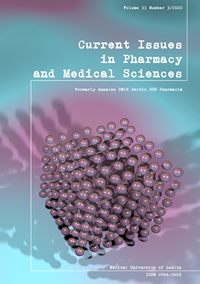Disturbances of extracellular protein metabolism in ceruleininduced pancreatitis
DOI:
https://doi.org/10.2478/cipms-2020-0022Keywords:
chronic pancreatitis, diabetes type 1, proteolysis, peptide poolAbstract
Chronic pancreatitis (CP) is still a serious clinical problem due to the significant difficulties in its diagnosis, especially in the initial stages of development. Among the mechanisms that mediate the pathogenesis of CP and lead to pancreatitis-related disorders is unregulated activation of proteolytic enzymes, namely, matrix metalloproteinases (MMPs). The aim of our study was to determine the disturbances of protein metabolism under the conditions of CP alone or in combination with diabetes type 1 (CP+DT1). Herein, CP was induced in the nonlinear male rats by intraperitoneal injection of cerulein (5 µg·kg-1 of body weight; five times during fives day). DT1 was modeled in the rats with CP by a single intraperitoneal injection of streptozotocin (65 mg·kg-1 of the body weight). The levels of MMP-2 and -9 were determined by enzyme-linked immune sorbent assay, and the level of low and middle molecular weight (LMMW) substance was measured spectrophotometrically, while the peptide fractions were analyzed by size exclusion chromatography. The present study revealed a significant increase of MMP-2 and MMP-9 levels in the serum, liver and pancreas of the rats with CP and CP+DT1. Elevated levels of MMPS may act as a factor for the initiation of subsequent cascade of events resulting in the development of pancreatitis-associated complications. Pathogenesis of chronic pancreatitis alone or in combination with diabetes type 1 has been accompanied by the formation and accumulation of LMMW substance, changes in peptide composition and level of individual peptides in the tissues of the rats. Such alterations are among key triggers of amplification of metabolic disorders under chronic pancreatitis.
References
1. Xiao AY, Tan ML, Wu LM, Asrani VM, Windsor JA, Yadav D, Petrov MS. Global incidence and mortality of pancreatic diseases: a systematic review, meta-analysis, and meta-regression of population-based cohort studies. Lancet Gastroenterol Hepatol. 2016;1(1):45-55.
2. Lerch MM, Gorelick FS. Early trypsinogen activation in acute pancreatitis. Med Clin North Am. 2000;84:549-63.
3. Hardt PD, Killinger A, Nalop J, Schnell-Kretschmer H, Zekorn T, Klör HU. Chronic pancreatitis and diabetes mellitus. A retro-spective analysis of 156 ERCP investigations in patients with insulin-dependent and non-insulin-dependent diabetes mellitus. Pancreatology. 2002;2(1):30-3.
4. Crowther JR. The ELISA guidebook. Methods Mol Biol. 2000;149 III-IV:1-413.
5. Bradford MM. A rаpid and sensitive method for quantities of utilizing the principle of protein binding, Anal. Biochem, 1976;86: 193-200.
6. Nykolaychyk BB, Moyn VM, Kyrkovskyy VV. Method for determining of the peptide pool molecular. Laboratory case. 1991;10: 13-8.
7. Paula H,Stephan K, Edouard E. Size-Exclusion Chromatography for the Analysis of Protein Biotherapeutics and their Aggregates. J Liq Chrom Relat Tech. 2012;35:2923-50.
8. Sternlicht MD, Werb Z. How matrix metalloproteinases regulate cell behavior. Annu Rev Cell Dev Biol. 2001;17:463-516.
9. Gordon GM, Ledee DR, Feuer WJ, Fini ME. Cytokines and signaling pathways regulating matrix metalloproteinase-9 (MMP-9) expression in corneal epithelial cells. J Cell Physiol. 2009;221(2):402-11.
10. Rosário HS, Waldo SW, Becker SA, Schmid-Schönbein GW. Pancreatic trypsin increases matrix metalloproteinase-9 accumulation and activation during acute intestinal ischemia-reperfusion in the rat. Am J Pathol. 2004;164(5):1707-16.
11. Śmigielski J, Piskorz Ł, Talar-Wojnarowska R, Malecka-Panas E, Jabłoński S, Brocki M. The estimation of metaloproteinases and their inhibitors blood levels in patients with pancreatic tumors. World J Surgical Oncology. 2013;11:137.
12. Sidelnikova VI, Chernitskiy AE, Retsky MI. Endogenous intoxication and inflammation: reaction sequence and informativity of the markers (review). Selskokhozyaistvennaya biologiya. 2015;50(2); 152-61.
13. Yakovlev MY. Elements of endotoxin theory of human physiology and pathology. Human Physiology. 2003;29(4):476-86.
14. Oettl K, Stauber RE. Physiological and pathological changes in the redox state of human serum albumin critically influence its binding properties. Br J Pharmacol. 2007;151(5):580-90.
Downloads
Published
Issue
Section
License
Copyright (c) 2020 Authors

This work is licensed under a Creative Commons Attribution-NonCommercial-NoDerivatives 3.0 Unported License.


